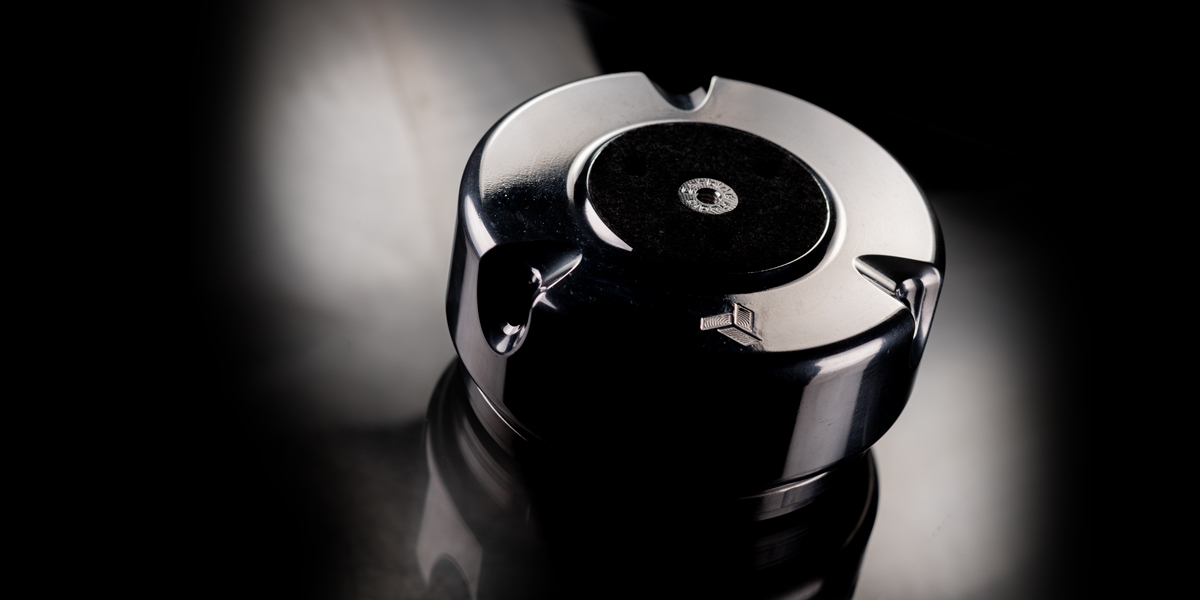The newcomer company Carbide Audio has only one product in its roster, but on appearance and topology this decoupling device baptized Carbide Base is unlike any other anti-vibration sorter I’ve seen. Now it’s time to find out whether it’s any good. Enjoy!
Viscoelastic smarts
Anti-vibration accessories aren’t frequent guests at this site, but those I’ve reviewed since its launch were beneficial where it mattered most and did exactly what their makers advertised. Testing such devices neither is complex nor difficult, their application nets pretty much instant sonic shifts and the only question to ask is about the direction and intensity of these changes. Having said that, Stacore’s Advanced platform and Ansuz Darkz T2S footers turned out intense enough to surpass the mildly effective supplementary status often associated with their decoupling kind. Performance spikes introduced by these two costly specimens were drastic by my standards and so were means to achieve such profound results. Both products are essentially directional sinks designed to absorb input resonances and prevent these vibrations from bouncing back up, but other than this they’re vastly different designs.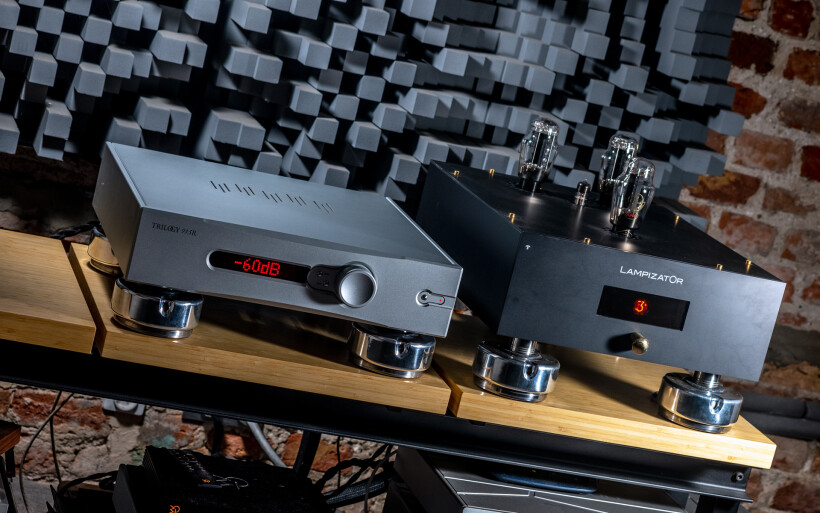 Stacore’s platform primarily made of Italian amorphous slate features an elaborate internal air suspension network, roller bearings and viscoelastic material in-between its top plate’s two layers. Ansuz’ each T2S footer comprises of 2 x 3 titanium balls in-between three ultra-hard titanium discs with tantalum, scandium and diamond skins etched deep into their primary surface. Although the former is an unapologetically massive full-sized behemoth and the latter is tiny puck, their respective roads fundamentally lead to the same place. Now let me introduce you to yet another one that’s unusually wide. In late October an introductory mail came from Carbide Audio’s founder Jeffrey Jenkins interested in sending my way his first commercial effort in form of anti-vibration accessories named Carbide Bases. I’m fine with handling a DAC, amp or speakers, but compact easy to handle decoupling pucks make me smile. Little did I know, the man’s were more of a land mine caliber and he dispatched 24 of these. Imagine my surprise upon receiving a 30 x 30 x 30cm package that showed 53kg on the scale…
Stacore’s platform primarily made of Italian amorphous slate features an elaborate internal air suspension network, roller bearings and viscoelastic material in-between its top plate’s two layers. Ansuz’ each T2S footer comprises of 2 x 3 titanium balls in-between three ultra-hard titanium discs with tantalum, scandium and diamond skins etched deep into their primary surface. Although the former is an unapologetically massive full-sized behemoth and the latter is tiny puck, their respective roads fundamentally lead to the same place. Now let me introduce you to yet another one that’s unusually wide. In late October an introductory mail came from Carbide Audio’s founder Jeffrey Jenkins interested in sending my way his first commercial effort in form of anti-vibration accessories named Carbide Bases. I’m fine with handling a DAC, amp or speakers, but compact easy to handle decoupling pucks make me smile. Little did I know, the man’s were more of a land mine caliber and he dispatched 24 of these. Imagine my surprise upon receiving a 30 x 30 x 30cm package that showed 53kg on the scale… 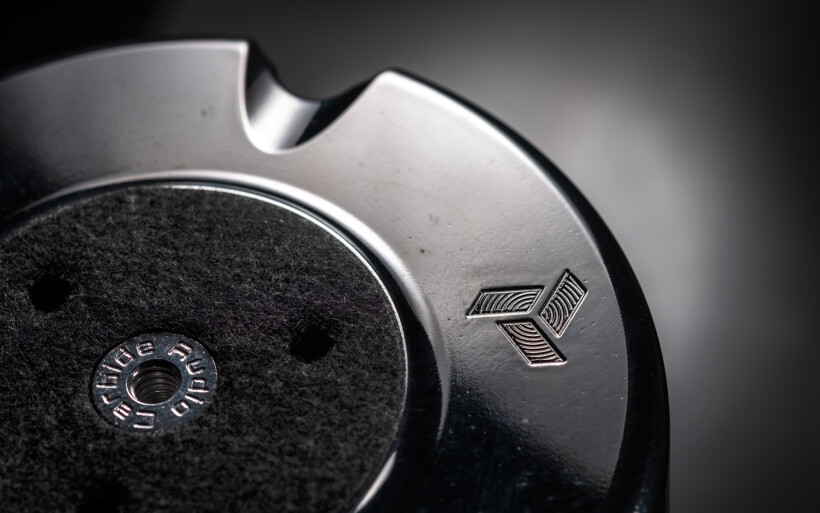 Since the name Carbide Audio didn’t ring any bells, the manufacturer’s site was my first stop. Cleanly executed buttoned-up look with easily accessible critical information implied Jeffrey’s commitment to the decoupling cause and overall seriousness. Anti-vibration products roughly divide into soft and hard, but each his footer combines multiple hard roller bearings with a soft viscoelastic ring aka ViscoRing for a two-fold action optimized to separately handle horizontal and vertical movement. The ring itself acts like a spring with a low spring rate for low resonance frequency, wide isolation bandwidth and over 65% of vibration energy converted into heat. Jeffrey explained that viscoelastic materials beat metal springs on resonance dissipation due to their higher loss factor, but achieving a low spring rate demands tall thin walls that naturally compromise stability. The tricky part was in landing a ring that’s mechanically stable under heavy loads and effective at its core job at the same time. It took two years of R&D to get there.
Since the name Carbide Audio didn’t ring any bells, the manufacturer’s site was my first stop. Cleanly executed buttoned-up look with easily accessible critical information implied Jeffrey’s commitment to the decoupling cause and overall seriousness. Anti-vibration products roughly divide into soft and hard, but each his footer combines multiple hard roller bearings with a soft viscoelastic ring aka ViscoRing for a two-fold action optimized to separately handle horizontal and vertical movement. The ring itself acts like a spring with a low spring rate for low resonance frequency, wide isolation bandwidth and over 65% of vibration energy converted into heat. Jeffrey explained that viscoelastic materials beat metal springs on resonance dissipation due to their higher loss factor, but achieving a low spring rate demands tall thin walls that naturally compromise stability. The tricky part was in landing a ring that’s mechanically stable under heavy loads and effective at its core job at the same time. It took two years of R&D to get there. 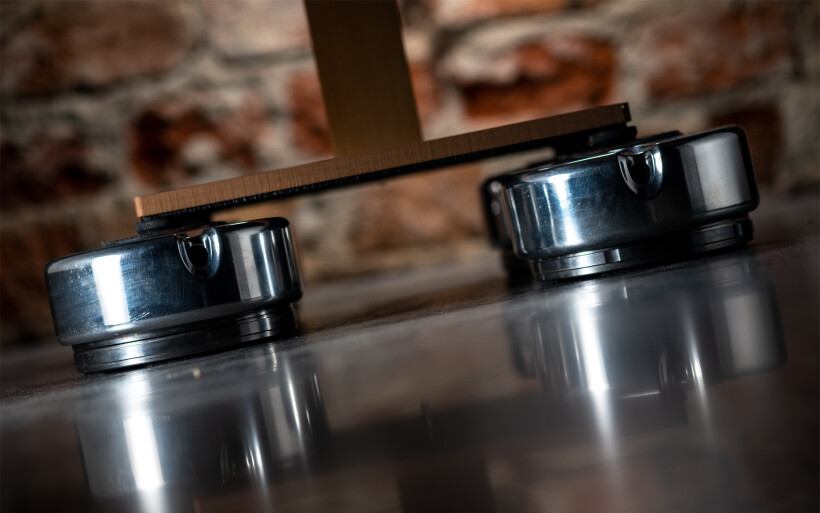 A single Carbide Base measures (W x H) 64 x 124mm and weighs about 2.2kg, which is a lot for a decoupler device. Still, upon taking a closer look at Jeffrey’s design it becomes apparent why it’s this large. Its internally threaded bottom section with three round felt pads houses a compact plate threaded outwards. The former’s turns regulate the entire structure’s height, which proved useful in case of my room’s uneven concrete floor. The small threaded piece bolts to a large plate just above and 6 x 3 tiny zirconia balls in-between them make this connection horizontally a bit loose. The latter element also is the bed for the critical ViscoRing, while the uppermost shiny piece’s cleverly milled inside locks this rubbery insert into place and prevents it from bulging. Protruding round felt pads on top of Carbide Bases prevent scratches upon resting a component on them. Each puck is also loaded with 1/4″-20 threaded top and bottom holes that easily accept optional spikes and allow for firmly fixing it to i.e. a speaker or DAC.
A single Carbide Base measures (W x H) 64 x 124mm and weighs about 2.2kg, which is a lot for a decoupler device. Still, upon taking a closer look at Jeffrey’s design it becomes apparent why it’s this large. Its internally threaded bottom section with three round felt pads houses a compact plate threaded outwards. The former’s turns regulate the entire structure’s height, which proved useful in case of my room’s uneven concrete floor. The small threaded piece bolts to a large plate just above and 6 x 3 tiny zirconia balls in-between them make this connection horizontally a bit loose. The latter element also is the bed for the critical ViscoRing, while the uppermost shiny piece’s cleverly milled inside locks this rubbery insert into place and prevents it from bulging. Protruding round felt pads on top of Carbide Bases prevent scratches upon resting a component on them. Each puck is also loaded with 1/4″-20 threaded top and bottom holes that easily accept optional spikes and allow for firmly fixing it to i.e. a speaker or DAC.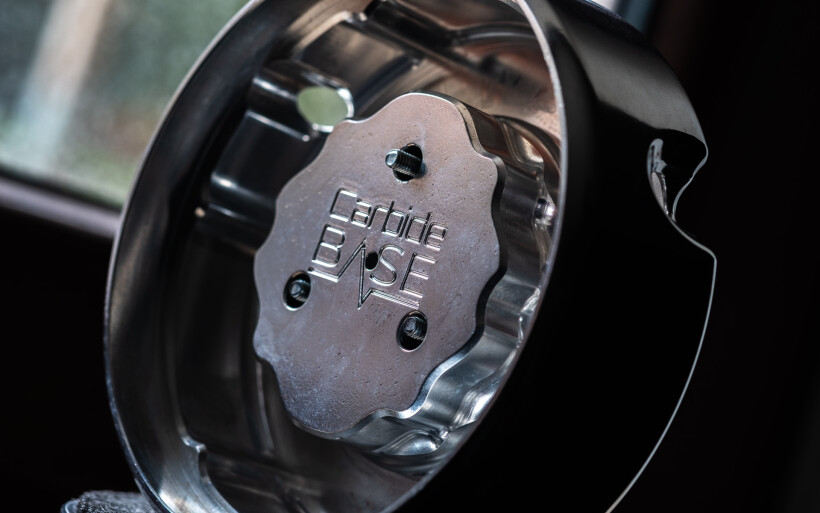 Elastic internal rings inside Carbide Bases compress under mass of devices put on them for cushion-like effect, but it’s quite clear that these massive footers were built to withstand a lot. On assembly, internal complexity and substantial feel alone the manufacturer’s asking price ($270/each) seems justified. If shiny silver as showcased in this review isn’t your color, semi-matte black is the alternative at no extra cost. A set of four light/medium/heavy ViscoRings supports respectively up to 32/64/318kg loads and they work best near their upper loading range. Should you need a different ring, each sells for $29 and is a breeze to replace. Just unscrew three small bolts on the uppermost enclosure piece to conveniently access its sticky elastic insert removable by hand, then pop in a new ring and bolt back its round compartment, that’s it. Easy-peasy. Now we should move to sonics, but during our mail exchange Jeffrey provided lots of useful info that eventually turned into a mini interview.
Elastic internal rings inside Carbide Bases compress under mass of devices put on them for cushion-like effect, but it’s quite clear that these massive footers were built to withstand a lot. On assembly, internal complexity and substantial feel alone the manufacturer’s asking price ($270/each) seems justified. If shiny silver as showcased in this review isn’t your color, semi-matte black is the alternative at no extra cost. A set of four light/medium/heavy ViscoRings supports respectively up to 32/64/318kg loads and they work best near their upper loading range. Should you need a different ring, each sells for $29 and is a breeze to replace. Just unscrew three small bolts on the uppermost enclosure piece to conveniently access its sticky elastic insert removable by hand, then pop in a new ring and bolt back its round compartment, that’s it. Easy-peasy. Now we should move to sonics, but during our mail exchange Jeffrey provided lots of useful info that eventually turned into a mini interview.
- Can you shed some light on your background? And how that connects to Carbide Audio as we know it today?
I am a software engineer so my background is in IT. I’ve been passionate about audio since I was a young kid listening to my grandfather’s audio equipment in the early 90’s. He was a DIY audiophile who built his own amplifiers at one point, so I like to think his passion to experiment in audio influenced me. My combined interests in audio and software led to experimenting with early audio software tools for things like digital room correction. These experiences spurred my interest in psychoacoustics and better understanding the influence the room has on our perception of sound and music. Through reading and experimentation I started to learn more about the importance of decoupling the room and equipment from vibrations. More recently, my background in software helped me explore other software tools for designing and modeling vibration decoupling designs. Programming knowledge helped me translate these designs into code that CNC manufacturing machines accept to machine parts. It was after acquiring all of the necessary tools to build and verify my own designs that I founded Carbide Audio to work on creating audio equipment full time.
- Was any of your other hobbies/activities helpful for your audio developments?
Outside of audio I’ve had some other hobbies which have been influential in the forming of Carbide Audio. I’m a bit of a shade tree mechanic having experience rebuilding old BMW engines. Hands-on experience with basic mechanical engineering concepts involving cars in my earlier years would later help me in my quest to innovate in the area of vibration isolation. Generally speaking, lots of hacking around with computers and mechanical things over the years has been influential in being inquisitive and trying to figure out how things work.
- When was Carbide Audio officially established?
Carbide Audio was established in March 2019. Our first product Carbide Base was launched in July 2021. The Carbide Base footers were about 2 years of research and design that would lead to a US patent application for the design.
- Where is your operation located?
Our machine shop and office space is located in the small town of Llano, Texas. Llano is located west of Austin in the Texas hill country. Fortunately Llano is a hub for ranch businesses in the area which has helped in having easy access to freight transport for raw materials and heavy equipment in and out of our business. When you’re moving in CNC machines that weigh over 6’000 kg, truck and freight access to such a remote location is an important consideration.
- Your viscoelastic material of choice, what incentivized you to use it in the first place?
Viscoelastic materials can be ideal for audio since they are so lossy. As the name implies they behave much like a viscous fluid under deflection, allowing intermolecular friction within the material to dissipate vibration energy as heat. The elastic property gives the materials sufficient resilience to support weight. The ratio of how viscous or how elastic the material is can be adjusted depending on application. In our footers for example, you can choose between more viscous but less elastic by using the gray ViscoRings as shipped in your samples, to the other end of the spectrum of being less viscous but more elastic by using the black ViscoRings. Higher elasticity translates into higher resilience for higher weight supporting ability at the expense of slightly less vibration dissipation aka damping. Carbide Bases utilize six different viscoelastic materials throughout, each of which is formulated for their specific application.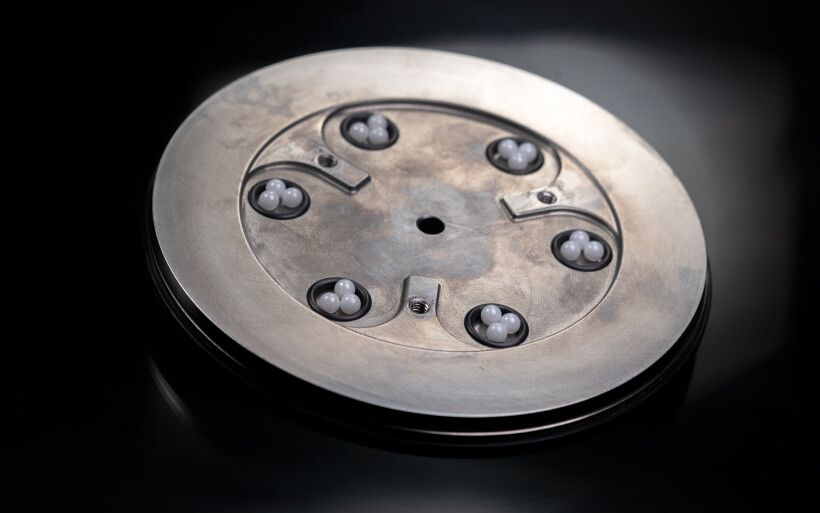 Viscoelastic materials can have some downsides, however. Most significantly is that it can be difficult to achieve a low resonance frequency mandatory for isolating low frequencies. It might seem counterintuitive but you don’t want a very large amount of the material spread horizontally over a wide surface area. It needs to be tall and thin in order to be able to act like a spring with a low spring rate, which is necessary for isolation of very low frequencies. But the problem there is stability, you can only go so far without risking having your equipment topple over. This is where Carbide Base is unique in that it was designed to provide a high level of stability using viscoelastic materials with a low inherent stability. Vertical ridges selectively brace the outside of the ViscoRing to prevent it from buckling, while simultaneously allowing most of the surface area to bulge under compression. Viscoelastic buffers repel against excessive horizontal deflection and tilting to further provide stability. This ability to use viscoelastic materials with a desirable shape is what allows for the isolation of such low frequencies. Without it, bass and midrange can sound muddy and congested. This is because around frequencies near the resonance frequency of the device, the vibrations passing through the device are actually amplified rather than reduced. All passive vibration isolators exhibit this characteristic. So we sought to push the resonance frequency down below the lower threshold of human hearing so any amplification that does occur is below what is experienced in music. Most of the competitors have much higher resonance frequencies which means poor isolation of low frequencies. Many audiophiles have a bad impression of viscoelastic isolators but this is because an insufficiently low resonance frequency is causing audible amplification of vibrations within the audible range.
Viscoelastic materials can have some downsides, however. Most significantly is that it can be difficult to achieve a low resonance frequency mandatory for isolating low frequencies. It might seem counterintuitive but you don’t want a very large amount of the material spread horizontally over a wide surface area. It needs to be tall and thin in order to be able to act like a spring with a low spring rate, which is necessary for isolation of very low frequencies. But the problem there is stability, you can only go so far without risking having your equipment topple over. This is where Carbide Base is unique in that it was designed to provide a high level of stability using viscoelastic materials with a low inherent stability. Vertical ridges selectively brace the outside of the ViscoRing to prevent it from buckling, while simultaneously allowing most of the surface area to bulge under compression. Viscoelastic buffers repel against excessive horizontal deflection and tilting to further provide stability. This ability to use viscoelastic materials with a desirable shape is what allows for the isolation of such low frequencies. Without it, bass and midrange can sound muddy and congested. This is because around frequencies near the resonance frequency of the device, the vibrations passing through the device are actually amplified rather than reduced. All passive vibration isolators exhibit this characteristic. So we sought to push the resonance frequency down below the lower threshold of human hearing so any amplification that does occur is below what is experienced in music. Most of the competitors have much higher resonance frequencies which means poor isolation of low frequencies. Many audiophiles have a bad impression of viscoelastic isolators but this is because an insufficiently low resonance frequency is causing audible amplification of vibrations within the audible range.
Viscoelastic materials also drain away vibrations, which is a bit different than vibration isolation. Much like how a heat sink dissipates heat from electronics, my material of choice dissipates vibration energy present in the device being supported. We published a small experiment we did showing this benefit here.
- Is there any way that your tech can be reduced in size? There also had to be a good reason why your introductory product is bigger versus other footers available on the market?
Carbide Bases are large indeed. We could have made them smaller but that would have required compromising performance. As the ViscoRing is made smaller and shorter, you begin to reduce the surface area that is free to bulge outward under compression which begins raising the resonance frequency. The ViscoRings are most optimally used near their maximum supporting weights and then their isolation performance is best. As the ViscoRings become smaller, that “sweet spot” for their stiffness becomes narrower. The ability to have such good isolation performance over such broad weight ranges simply necessitated a larger size. Additionally, the inclusion of the separate lower stainless steel section with its zirconia ball bearings slightly raised the total height yet greatly improves horizontal isolation performance. These tiny spheres are roughly the same hardness as the more common alumina oxide ceramic ball bearings, but also over three times as tough so much less likely to fracture. Our pursuit of the absolute best in isolation and damping performance had to come at a price of a fairly large size. The upper limit of Carbide Bases was designed so that placing them under speakers would not raise the total height enough to perceptively alter the sound. The change in vertical angle from a typical listening position is usually less than one degree of vertical angle difference. Often it’s less than half that for speakers with already tall floor spikes. We went through quite a lot of iterations to shave off every possible millimeter from the total height and achieve our high performance goals regardless.
Our pursuit of the absolute best in isolation and damping performance had to come at a price of a fairly large size. The upper limit of Carbide Bases was designed so that placing them under speakers would not raise the total height enough to perceptively alter the sound. The change in vertical angle from a typical listening position is usually less than one degree of vertical angle difference. Often it’s less than half that for speakers with already tall floor spikes. We went through quite a lot of iterations to shave off every possible millimeter from the total height and achieve our high performance goals regardless.
- It looks like your ViscoRigns are removable and can be replaced?
Viscoelastic materials are inherently very tacky which can make separation of the footer and removal of the ring a slow and arduous process. You won’t hurt the ring, it’s actually quite hard to tear. You can pull on it but some patience is advised. ViscoRings are coated to make their removal easier. Since the softer materials are quite a bit more tacky than the harder ones, my blue (medium) and black (heavy) ViscoRings are quite a bit easier to remove.
- Your own machine park tells us that Carbide Bases are fully in-house made devices?
Correct, we own our own machine shop and CNC machines where we do all of our production. In-house machining is not necessary, but it has the added benefit of complete control and it allows for immediate tests of each design iteration we make. Ultimately I think this ability to rapidly iterate yields the highest quality end product. In the software field we call this agile development.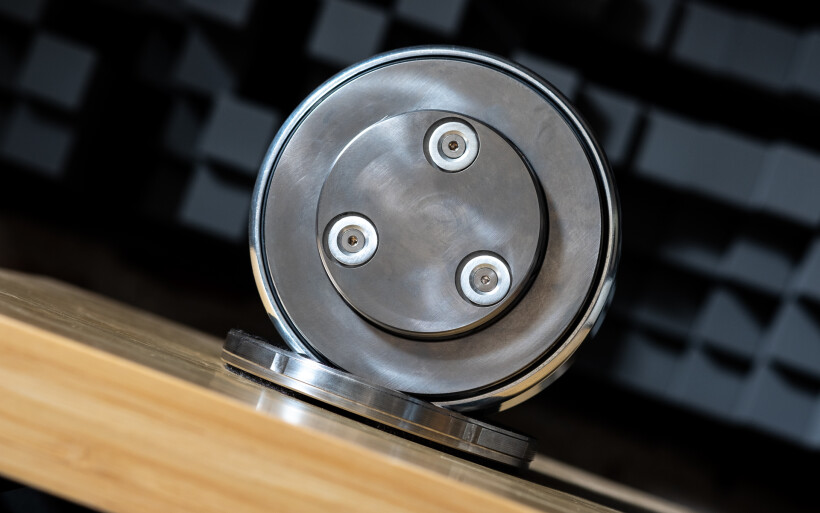
- How many footers should I use under each product?
Under relatively lighter equipment three Carbide Bases might actually sound better than four. Then their operation will be near the maximum supporting weight for pre-installed VisoRings, thus their resonance frequency will be the lowest. It’s perfectly fine going over the maximum recommended weight for a given ViscoRing, but after a point its vertical isolation will be reduced. Then it’s best to step up to the stiffer counterpart. I use just three Carbide Bases under Chord Dave DAC in my system.
- How many people work with you at the moment?
Although now there’s only me plus one other employee, establishing Carbide Audio would not have been possible without the frequent part time help of three family members, two of which are talented engineers. I’ve been fortunate to be able to surround myself with people much smarter than I am!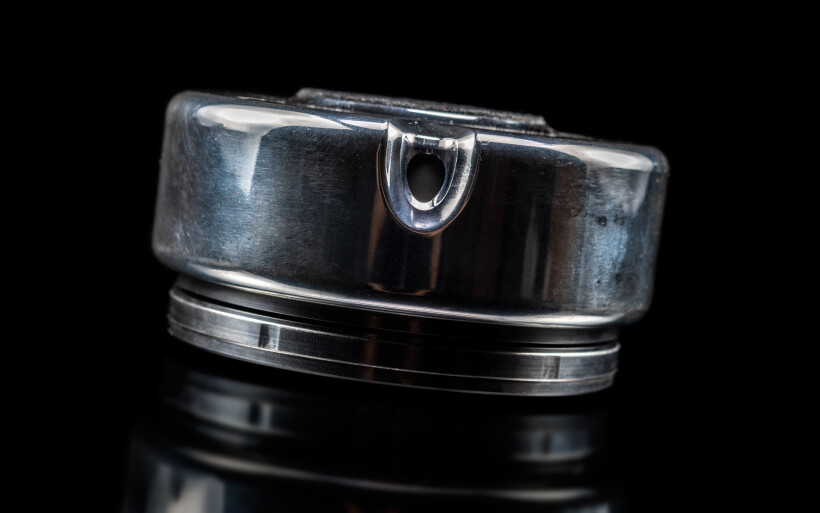
- How did you end up with Carbide Audio as you company’s name?
It’s a reference to the specific tools known as carbide end mills we use during machining. They’re made out of cemented carbide material which is very hard making it ideal for cutting metals. The logo was designed to represent the end of a spinning three-fluted carbide end mill used to machine the aluminum upper portion of each Carbide Base. End mills used for steels have more but shallower flutes.
- The largest piece that houses your ViscoRing looks like it was cast and then milled on the inside, at least that’s what its somewhat grainy texture tells us?
Although we don’t cast these parts, it would be a logical assumption given their shape. Instead we take 3.5-meter long 230kg round bars of solid aluminum billet and chop them up into 50mm discs. The machining process produces some tool cutting marks as expected, but most will simply blast or chemically etch to produce a matte finish. To get closer to a mirror like finish we incorporate some extra steps, one of which is a chemical brightening process that exposes some of the underlying natural aluminum grain that looks like cast under some lighting. The black finish version is a bit more muted in this regard, as is to be expected with a darker color.
My turn
Two dozens of Carbide Bases sent over by Jeffrey were more than enough to cover my entire setup. Their conservative application – here I mean three his hefty footers per product – meant simultaneous action under two speakers, two monos, a DAC, preamp, server/streamer and linear PSU. Although going the full hog right away seemed appealing, all the hassle associated with lifting pretty much my entire platform wasn’t. Besides, as a paying customer interested in Carbide Audio’s decouplers I’d like to read about their input under specific components and learn where they work best prior to any financial commitments. That’s why my to-do list included three separate stops; sound|kaos Vox 3afw monitors, Trilogy 915R preamp and LampizatOr Pacific DAC in that exact order. Then the remaining Carbide Bases landed under my monos and linear PSU.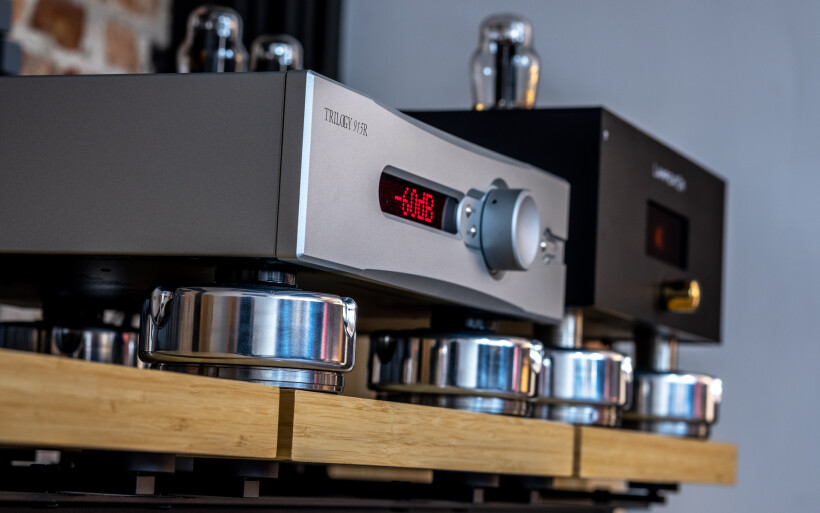 Compact light sound|kaos Vox 3afw speakers fixed to their skinny legs and bottom plates are a breeze to move from one place to another, so using them with Carbide Bases was the simplest most convenient exercise I could do. These monitors toed in to cross at the main listening chair some 150cm away form with it a semi-nearfield setup that’s off-charts on imaging. After a short listen each speaker was put on/off three today’s pucks located just in front, while the listening seat had to move some 30cm further/closer to maintain that isosceles triangle and very much headphone-alike spatial immersion. Not only these swaps were very easy to make, just two were all it took to track quite obvious highly impressive sonic changes.
Compact light sound|kaos Vox 3afw speakers fixed to their skinny legs and bottom plates are a breeze to move from one place to another, so using them with Carbide Bases was the simplest most convenient exercise I could do. These monitors toed in to cross at the main listening chair some 150cm away form with it a semi-nearfield setup that’s off-charts on imaging. After a short listen each speaker was put on/off three today’s pucks located just in front, while the listening seat had to move some 30cm further/closer to maintain that isosceles triangle and very much headphone-alike spatial immersion. Not only these swaps were very easy to make, just two were all it took to track quite obvious highly impressive sonic changes.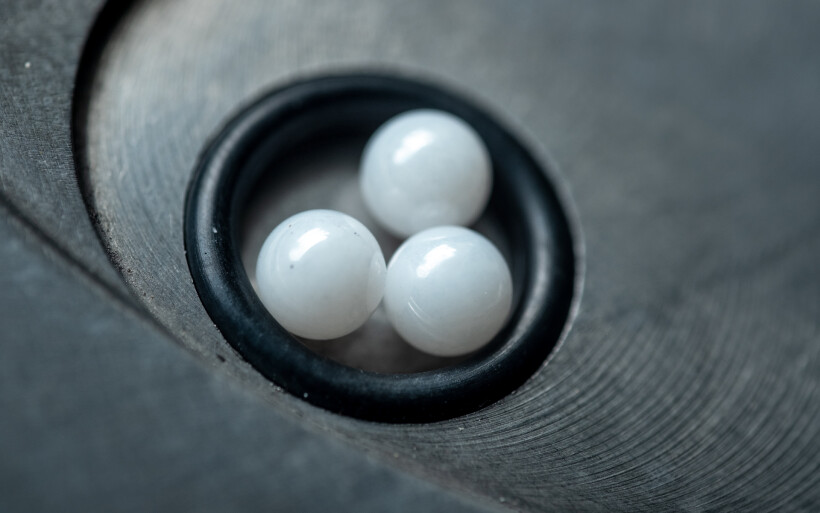 The song “Keep It Together” by Trent Reznor’s second band How to Destroy Angels opens up with gentle synth effects followed by massive slow bass blows, among which Mariqueen Maandig’s delicate soothing ethereal voice is heard on a black somewhat stuffy background. The initial impression with Jeffrey’s footers on the job was as if SPL got reduced by some 3dB, but many decouplers and noise-killing cables are alike on this front early on. sound|kaos Vox 3afw with Carbide Bases underneath rendered the key vocal line visibly smoother, more moist, closer to my ears, outlined finer and significantly more specific in result. Lesser bass output in my listening cave was the next easily traceable sonic rework, or at least that’s how Swiss monitors felt like at first, but past the accommodation phase their different interaction in that space went beyond just that. Carbide Audio’s pucks removed excess wobble I got so accustomed to that normally it remains undetected. We don’t know what we don’t know until we do. This instantly heard trimming procedure that effectively reduced room talk allowed Martin Gateley’s monitors to tap into extra power reserves in form of greater low end extension and speedier more firm delivery overall. The main bass line on “Keep it Together” now felt more visceral, tighter, raw and properly palpable in my chest. Needless to say, the pleasant sensation that followed implied a major move up on the quality ladder.
The song “Keep It Together” by Trent Reznor’s second band How to Destroy Angels opens up with gentle synth effects followed by massive slow bass blows, among which Mariqueen Maandig’s delicate soothing ethereal voice is heard on a black somewhat stuffy background. The initial impression with Jeffrey’s footers on the job was as if SPL got reduced by some 3dB, but many decouplers and noise-killing cables are alike on this front early on. sound|kaos Vox 3afw with Carbide Bases underneath rendered the key vocal line visibly smoother, more moist, closer to my ears, outlined finer and significantly more specific in result. Lesser bass output in my listening cave was the next easily traceable sonic rework, or at least that’s how Swiss monitors felt like at first, but past the accommodation phase their different interaction in that space went beyond just that. Carbide Audio’s pucks removed excess wobble I got so accustomed to that normally it remains undetected. We don’t know what we don’t know until we do. This instantly heard trimming procedure that effectively reduced room talk allowed Martin Gateley’s monitors to tap into extra power reserves in form of greater low end extension and speedier more firm delivery overall. The main bass line on “Keep it Together” now felt more visceral, tighter, raw and properly palpable in my chest. Needless to say, the pleasant sensation that followed implied a major move up on the quality ladder.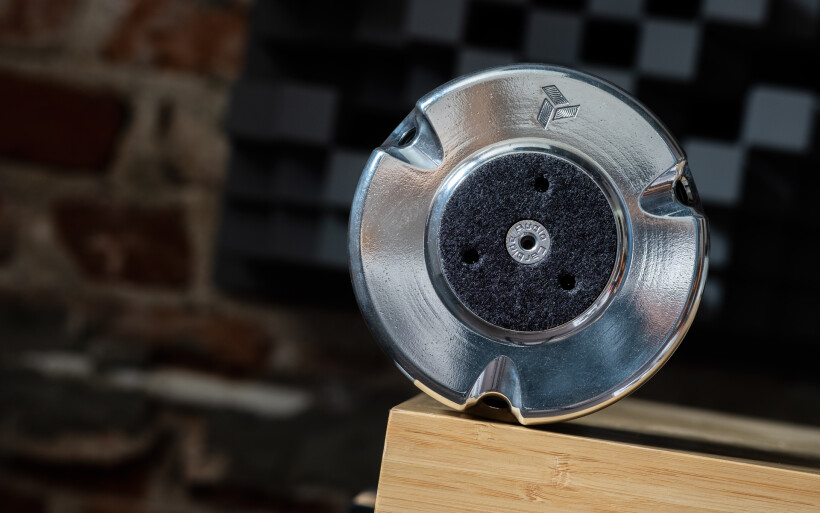 The two key changes described above surely were a splendid start, but Carbide Bases’ input didn’t stop there. Drum machine snaps heard on the same HDTA’s song were shorter and sensibly stronger, its backdrop got darker, resolution and moisture went up and so did oxygenation and clarity. The general vibe on that tune became somewhat darker and substantial yet more orderly and free from sparks previously heard here and there, while its natural tonal balance to my ears wasn’t altered but rather restored. The outcome with Jeffrey’s footers engaged was posh, atmospheric, precise and enjoyable without any drawbacks. Although there was nothing to dislike, my investigation was far from over. The Vox 3afw’s properly guttural performance liberated from any hollowness and rough edges incentivized me to have a listen to Acid’s “Creeper” loaded with stout bass stunts, zippy subsidiary synth pulses, high dynamic contrasts and distinctively calm vocal line that nicely connects everything. This track is also very useful in mapping any issues with vented speakers; bass-reflex farts and abnormal boom. Carbide Bases underneath Swiss petites yet again produced admirably extended, controlled, powerful and squeaky clean lows. Upon removing Jeffrey’s sorters this range instantly took a hit to become lazier, slower, more wooly and less impactful. The vocalist now sounded coarser; more chiseled, shinier and less sensual, but also rendered deeper on stage for a more hooded effect.
The two key changes described above surely were a splendid start, but Carbide Bases’ input didn’t stop there. Drum machine snaps heard on the same HDTA’s song were shorter and sensibly stronger, its backdrop got darker, resolution and moisture went up and so did oxygenation and clarity. The general vibe on that tune became somewhat darker and substantial yet more orderly and free from sparks previously heard here and there, while its natural tonal balance to my ears wasn’t altered but rather restored. The outcome with Jeffrey’s footers engaged was posh, atmospheric, precise and enjoyable without any drawbacks. Although there was nothing to dislike, my investigation was far from over. The Vox 3afw’s properly guttural performance liberated from any hollowness and rough edges incentivized me to have a listen to Acid’s “Creeper” loaded with stout bass stunts, zippy subsidiary synth pulses, high dynamic contrasts and distinctively calm vocal line that nicely connects everything. This track is also very useful in mapping any issues with vented speakers; bass-reflex farts and abnormal boom. Carbide Bases underneath Swiss petites yet again produced admirably extended, controlled, powerful and squeaky clean lows. Upon removing Jeffrey’s sorters this range instantly took a hit to become lazier, slower, more wooly and less impactful. The vocalist now sounded coarser; more chiseled, shinier and less sensual, but also rendered deeper on stage for a more hooded effect. Highly resolving efficient Swiss monitors on top of Carbide Bases enjoyed their thoroughly beneficial contribution, that was the clear takeaway. More sorted imaging, finer differentiation of virtual sound sources and extra smoothness truly mattered. Ditto limited room interaction, greater clarity and might, finer textures, higher contrasts and elevated saturation. The total tab for this desirable service included softer edges and lower midbass presence, so wasn’t extortionate by any means. The Vox 3afw’s more civilized, polished and fleshy performance stripped from nervousness and more potent on slams secured a big win. Speaking cosmetics, four footers per channel looked better than three that had a slight edge on performance, so this time around less was more indeed. Although the experience with Carbide Bases under Vox 3afw resulted in findings meaningful, potent and blunt enough to wrap this story, my DAC and preamp enjoy decoupling too much to cut these corners. I had to press on.
Highly resolving efficient Swiss monitors on top of Carbide Bases enjoyed their thoroughly beneficial contribution, that was the clear takeaway. More sorted imaging, finer differentiation of virtual sound sources and extra smoothness truly mattered. Ditto limited room interaction, greater clarity and might, finer textures, higher contrasts and elevated saturation. The total tab for this desirable service included softer edges and lower midbass presence, so wasn’t extortionate by any means. The Vox 3afw’s more civilized, polished and fleshy performance stripped from nervousness and more potent on slams secured a big win. Speaking cosmetics, four footers per channel looked better than three that had a slight edge on performance, so this time around less was more indeed. Although the experience with Carbide Bases under Vox 3afw resulted in findings meaningful, potent and blunt enough to wrap this story, my DAC and preamp enjoy decoupling too much to cut these corners. I had to press on. It quickly turned out that Carbide Bases’ input with Swiss monitors nicely set the stage for components that came afterwards. Each benefit listed above still applied, but some things were new. Trilogy’s 915R preamp with Jeffrey’s pucks underneath portrayed more oxygenated and open landscapes for a visibly grander effect, followed by a wider dynamic range and virtual sound sources rendered a bit closer so visibly taller and more tangible. These changes were somewhat less pronounced in comparison to triangulations with speakers, but audibly beneficial still. More physiological and moist vocals on larger canvas seasoned with boom-free immediate bass response were clear sonic improvements rather than moves sideways.
It quickly turned out that Carbide Bases’ input with Swiss monitors nicely set the stage for components that came afterwards. Each benefit listed above still applied, but some things were new. Trilogy’s 915R preamp with Jeffrey’s pucks underneath portrayed more oxygenated and open landscapes for a visibly grander effect, followed by a wider dynamic range and virtual sound sources rendered a bit closer so visibly taller and more tangible. These changes were somewhat less pronounced in comparison to triangulations with speakers, but audibly beneficial still. More physiological and moist vocals on larger canvas seasoned with boom-free immediate bass response were clear sonic improvements rather than moves sideways.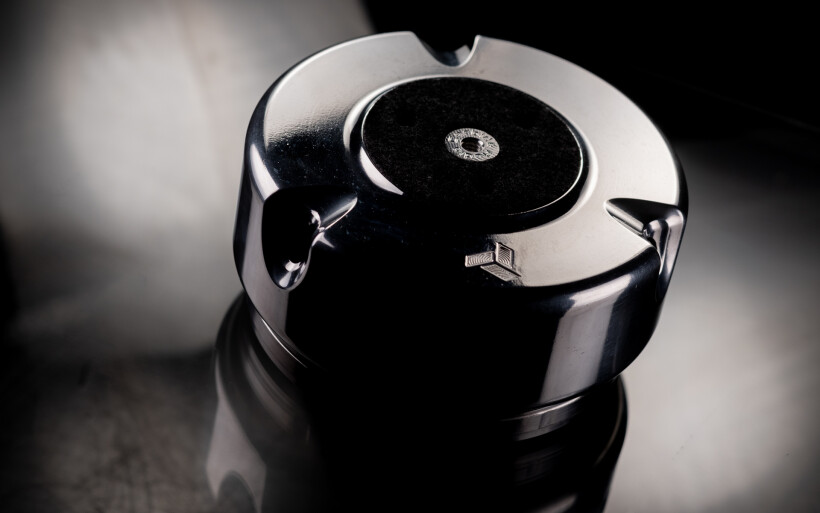 Next Carbide Bases had to work under the Pacific DAC as the only one in my platform loaded with proper hard decouplers, here made by the local company Stacore. This LampizatOr known for quickness, radiance, openness and directness is also somewhat lean, very unforgiving and voiced quite oppositely in comparison to warm dense sonics many enthusiasts so often associate with tubes. Without today’s footers this DAC performed as if its core profile was pushed too far to produce sharper edges, lower tonal mass, lesser hydration and a touch pale instrumental structures. Yet again it’s worth noting that I’ve been living with this spicy flavor for two years so am quite accustomed to it, but the most noticeable sonic shift was found elsewhere. The Pacific’s naturally snappy disposition would leave one to think that its quickness is bound to suffer upon injecting extra weight and color. These things usually are mutually exclusive, but not today. Carbide Bases not only turned my DAC into a gutsier and rounder version of itself, but also faster and dynamically more gifted on top of that. This sensibly more elastic, orderly and optically grander outcome was quite the surprise for me.
Next Carbide Bases had to work under the Pacific DAC as the only one in my platform loaded with proper hard decouplers, here made by the local company Stacore. This LampizatOr known for quickness, radiance, openness and directness is also somewhat lean, very unforgiving and voiced quite oppositely in comparison to warm dense sonics many enthusiasts so often associate with tubes. Without today’s footers this DAC performed as if its core profile was pushed too far to produce sharper edges, lower tonal mass, lesser hydration and a touch pale instrumental structures. Yet again it’s worth noting that I’ve been living with this spicy flavor for two years so am quite accustomed to it, but the most noticeable sonic shift was found elsewhere. The Pacific’s naturally snappy disposition would leave one to think that its quickness is bound to suffer upon injecting extra weight and color. These things usually are mutually exclusive, but not today. Carbide Bases not only turned my DAC into a gutsier and rounder version of itself, but also faster and dynamically more gifted on top of that. This sensibly more elastic, orderly and optically grander outcome was quite the surprise for me. After conducting three different experiments as described I had all the intel necessary to finish this assignment, but just to ease my curiosity this report’s oversized pucks had to land under my linear PSU and monos. As predicted, their application at these two locations was less audible than before and rather mild in comparison, but darker backdrop, higher O2 content and beefier more grounded sonics served without any penalties pushed my setup’s performance a notch higher still. Now the removal of all 24 footers used in there was the last task on my list. Suffice it to say, without these shiny objects on the job my platform didn’t instantly collapse but sounded noticeably inferior; smaller, slimmer, glossier, shallower, more distant, chalky, a fair bit nervous, less juicy and wobbly on bass. That performance plunge was as heard as it was felt and accepting it took me a while, but that’s the exact aftertaste efficacious sorters leave us with. If their inclusion doesn’t quite tell the full story right away, removing them after several hours on the clock surely will. Although the carbide dagger didn’t cut through major arteries on this front, it went in deep enough to leave a nasty scar and something for me to think about.
After conducting three different experiments as described I had all the intel necessary to finish this assignment, but just to ease my curiosity this report’s oversized pucks had to land under my linear PSU and monos. As predicted, their application at these two locations was less audible than before and rather mild in comparison, but darker backdrop, higher O2 content and beefier more grounded sonics served without any penalties pushed my setup’s performance a notch higher still. Now the removal of all 24 footers used in there was the last task on my list. Suffice it to say, without these shiny objects on the job my platform didn’t instantly collapse but sounded noticeably inferior; smaller, slimmer, glossier, shallower, more distant, chalky, a fair bit nervous, less juicy and wobbly on bass. That performance plunge was as heard as it was felt and accepting it took me a while, but that’s the exact aftertaste efficacious sorters leave us with. If their inclusion doesn’t quite tell the full story right away, removing them after several hours on the clock surely will. Although the carbide dagger didn’t cut through major arteries on this front, it went in deep enough to leave a nasty scar and something for me to think about.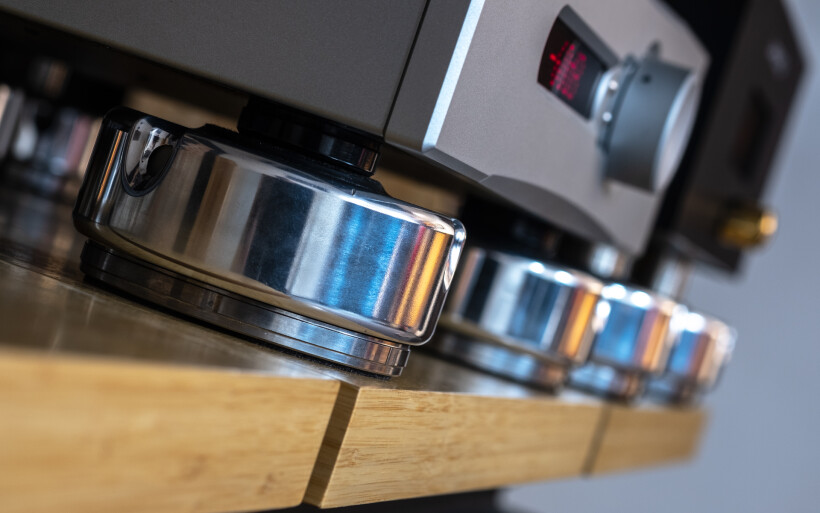 It’s time to point out that my setup free from any resident decouplers was a very friendly environment for Carbide Audio’s sorters. Their triumph over a rival who didn’t even show up was easy, but a comparison to similar accessories would’ve been very useful and that I have to leave to others. It’s also worth knowing that big heavy Carbide Bases won’t fit everywhere and their ViscoRings can’t be any smaller, so seeing this tech downscaled and more affordable is a rather unlikely scenario. These massive tank-alike pucks score commensurably high on perceived value, but visually are modest industrial lookers far away from the luxurious status. Their maker had performance on the very top of his priority list and that’s clear, but wrapping it in a sizeable weighty package beyond the industry standard isn’t a deal breaker by any means. Subjectively speaking, under large hardware Carbide Bases look cool.
It’s time to point out that my setup free from any resident decouplers was a very friendly environment for Carbide Audio’s sorters. Their triumph over a rival who didn’t even show up was easy, but a comparison to similar accessories would’ve been very useful and that I have to leave to others. It’s also worth knowing that big heavy Carbide Bases won’t fit everywhere and their ViscoRings can’t be any smaller, so seeing this tech downscaled and more affordable is a rather unlikely scenario. These massive tank-alike pucks score commensurably high on perceived value, but visually are modest industrial lookers far away from the luxurious status. Their maker had performance on the very top of his priority list and that’s clear, but wrapping it in a sizeable weighty package beyond the industry standard isn’t a deal breaker by any means. Subjectively speaking, under large hardware Carbide Bases look cool.
Although I didn’t have any standalone reference anti-vibration footers at my disposal, Jeffrey Jenkins’ introductory effort isn’t any less valid because of that. No blind luck secured this first win but the man’s decoupling method of choice that turned out efficacious regardless of application; brilliant under speakers, highly beneficial with a DAC and meaningful elsewhere. All in all, color me impressed. My sincere congratulations to Carbide Audio’s founder for landing such a portfolio opener and keeping its price tag sane. ‘Til next time!
Associated Equipment:
- Amplifier: Trilogy 995R
- DAC: LampizatOr Pacific (KR Audio T-100 / Living Voice 300B + KR Audio 5U4G Ltd. Ed.)
- Speakers: Boenicke Audio W11 SE+, sound|kaos Vox 3afw
- Transport: Innuos Statement
- Preamplifier: Trilogy 915R
- Speaker cables: Boenicke Audio S3, LessLoss C-MARC
- Speaker signal conditioning: LessLoss Firewall for Loudspeakers
- Interconnects: LessLoss Entropic Process C-MARC, Boenicke Audio IC3 CG
- Power components: Gigawatt PC-3 SE EVO+/LC-3 EVO, LessLoss C-MARC, Boenicke Audio Power Gate, iFi audio PowerStation, ISOL-8 Prometheus
- USB components: iFi audio Mercury3.0
- Rack: Franc Audio Accesories Wood Block Rack
- Network: Fidelizer EtherStream, Linksys WRT160N
- Music: NativeDSD
Retail prices of reviewed components in EU (excl. tax):
- Carbide Audio Carbide Base: $270/each
Manufacturer: Carbide Audio


